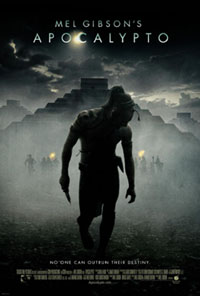 APOCALYPTO
APOCALYPTO(R)
**1/2 (out of 5)
December 8, 2006
STARRING
Rudy Youngblood as JAGUAR PAW
Dalia Hernandez as SEVEN
Jonathan Brewer as BLUNTED
Morris Birdyellowhead as FLINT SKY
Carlos Emilio Baez as TURTLES RUN
Ramirez Amilcar as CURL NOSE
Ireael Contreras as SMOKE FROG
Studio: Touchstone
Directed by: Mel Gibson
BY KEVIN CARR
Listen to Kevin’s radio review…
Two years ago, Mel Gibson snubbed conventional wisdom and Hollywood in general by making “The Passion of the Christ.” Not only did he make a strictly faith-based film (at a time when “The Omega Code” and its $12 million gross was the biggest success of this genre), but he also chose to present the dialogue in Latin and Aramaic. Everyone predicted the movie would tank in wide release.
But Gibson bucked the system and, with a strong grass-roots Christian movement, led “The Passion of the Christ” to become an international hit. Now, Gibson is attempting to create lightning in a bottle again with his new film, “Apocalypto.”
The film tells the story of a peaceful native tribe in the jungle of the Yucatan Peninsula that is decimated by Mayan warriors. After slaughtering about half of the village, the Mayans take the survivors prisoner. The women are sold into servitude, and the men are brought to the majestic temples for human sacrifice. One of the natives manages to escape and seeks revenge on the Mayans as he races to get home to his pregnant wife left at the village.
The title of the film means “a new beginning,” not “the end of the world” as many people assume. The new beginning in the movie has multiple meanings. On one hand, it shows a new beginning for this poor native village that was ripped apart by the Mayans. It’s also a new beginning for the Mayans, whose civilization was in decline. Finally, it’s a new beginning for the entire land because the story takes place on the eve of the arrival of the Spanish explorers.
While there are many similarities with “The Passion of the Christ,” “Apocalypto” is lacking in the more important areas. What helped propel “The Passion” to success was it’s Christian base. However, there’s no built-in market for “Apocalypto,” unless Gibson was aiming for descendants of Spanish Conquistadors.
Additionally, while the message of “The Passion” was clear, it’s really murky in “Apocalypto.” I never quite figured out why he made this movie. It certainly doesn’t present Mayans in good light, and the natives in the village are more victims than heroes. Maybe Gibson was trying to say that it wasn’t so bad that Europeans eventually clashed with the natives and left their culture in ruin.
Rather than looking at “Apocalypto” as a historical movie, it’s more appropriate to look at it like a horror film. There’s plenty of violence and gore to cover this. If you thought “The Passion” was violent, your head will spin in “Apocalypto.” It’s definitely not something for the kiddies or the feint at heart.
Consider this to be “The Hills Have Eyes” in the jungle. It fits that modern horror movie structure perfectly. Instead of mutants attacking a family in the desert, Mayan warriors attack a village in the jungle. People are killed, and others are kidnapped. Then one man escapes and proceeds to kick the holy hell out of the bad guys.
Cinematically, “Apocalypto” is brilliant. While there’s some clunky digital effects that break down, leaving me longing for practical stunts, the movie is incredible to watch. And the subtitles aren’t that bad because it’s not exactly a dialogue-heavy movie. The biggest stumbling blocks are a murky message, too much violence and an ultimately depressing and unsettling story.
Still, I will give Gibson credit for being unabashedly politically incorrect. He’s one of the few filmmakers out there who has the courage to present the ugly parts of history without apology.
Podcast: Play in new window | Download
